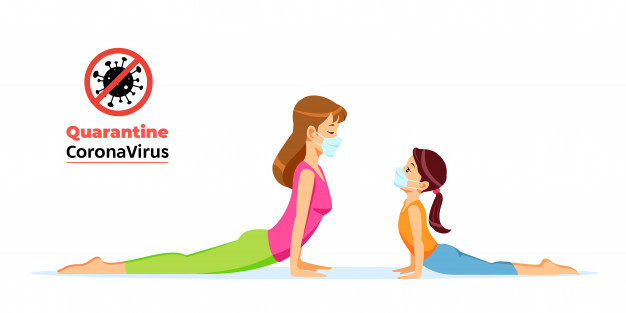According to the Health Department, about 80% of patients with Covid-19 may be asymptomatic or have few symptoms, approximately 20% require hospital care.
As it is a new disease and even though we have countless studies carried out and / or being carried out to date, there is still a lot of information to conclude the clinical questions about post-Covid-19.
What we can say is that it is a disease that does not only affect the respiratory system and more and more people appear with sequelae in different parts of the body, and this requires an increasingly close look at our student. So, I prepared this article to show you the importance of Pilates post-Covid-19 and present some tips and exercises for you to work with your recovered student.
What is the importance of physical activities for the immune system?
Physical exercise is considered a factor, among many, that help the immune system, and consequently a healthy life, mainly for preventing overweight and chronic non-communicable diseases (diabetes and hypertension, for example). However, the immune response from exercise is related to factors such as: regularity, intensity, duration and type of effort applied. It can even be harmful to the practitioner depending on the training! Physical exercises practiced in a moderate way, stimulate immune cells – with anti-inflammatory characteristics – and also provide an increase in the concentration of leukocytes circulating in blood vessels (remaining high, with a peak of 30-120 min after physical activity), which can persist for up to 24 hours after exercising.
Long-term (after 90 minutes) or high-intensity activities, without adequate rest (48 hours for intense aerobic activities), can cause a decrease in immune cells, opening a window for infectious diseases. Therefore, when an individual does a training without monitoring it can cause a great stress on his organism, generating a decrease in immune cells. In this context, the phrase “the more the better” is not applied, after all, even physical exercise has restrictions and contraindications. However, what we know today is that regular physical activity provides: Decreased mortality from pneumonia and influenza; Improvements in cardiorespiratory function; Improves the response to the vaccine; Increases the metabolism of glucose, lipids and insulin. We are not sure how physical activity improves immunity to specifically fight Coronavirus, but we have evidence of its benefits in combating and reducing the symptoms of other infectious respiratory diseases.
Therefore, when an individual does a training without monitoring it can cause a great stress on his organism, generating a decrease in immune cells. In this context, the phrase “the more the better” is not applied, after all, even physical exercise has restrictions and contraindications. However, what we know today is that regular physical activity provides: Decreased mortality from pneumonia and influenza; Improvements in cardiorespiratory function; Improves the response to the vaccine; Increases the metabolism of glucose, lipids and insulin. We are not sure how physical activity improves immunity to specifically fight Coronavirus, but we have evidence of its benefits in combating and reducing the symptoms of other infectious respiratory diseases.
Effects caused by Covid-19
Covid-19 is a new coronavirus not seen in humans until the end of 2019, but coronavirus viral pathogens are a considerable family of viruses that cause everything from simple colds to more serious diseases like the Middle East Respiratory Syndrome (MERS-CoV ) and Severe Acute Respiratory Syndrome (SARS). Similar to SARS-CoV, the new coronavirus uses a structural glycoprotein to infect our cells, it depends on this infection to multiply and survive. The protein that this virus multiplies more easily is present in the cardiac, pulmonary, renal, intestinal, and vascular cells. Therefore, it can alter various systems of our body and can cause serious consequences. The severity of the disease is related to the inflammatory substances already present in our bodies.
Symptoms that persisted after 6 months of infection were: Fatigue; Malaise after effort; Cognitive dysfunction (“brain fog”); Neurological sensations: neuralgia, weakness, cold, sensation of electric shock, facial paralysis, pressure, and numbness; Headaches; Memory problems; Insomnia; Muscle aches; Palpitations; Shortness of breath; Dizziness and balance problems; Speech and language problems.
Conclusion
The advantage of Pilates over other physical activities for the recovery of post-Covid-19 patients is the question of monitoring breathing in each movement, body awareness and the fact that the Method trains the individual’s concentration during a well-performed and properly monitored session. by the instructor. However, because it is a new disease, much study and research is still needed so that we can close a rehabilitation, a training program, increasingly more specific and specific to each student. Thus, it is up to us to carry out an assertive assessment and take care of the symptoms that most bother our post-Covid-19 student and for that, it is very important that the instructor is always interested and updated with each discovery.
Discover more from Pilates All Ages
Subscribe to get the latest posts sent to your email.
